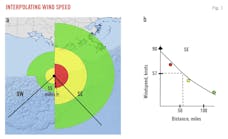Less important than 11 families changed forever yet fateful all the same are two other legacies of last year's Macondo tragedy with which the offshore oil and gas industry will contend for many years. One has a constructive dimension and the other, much less so.
One legacy is public distrust. Before BP's Macondo well blew out on Apr. 20, 2010, causing a rig explosion that killed 11 workers, Outer Continental Shelf producers had assured regulators—and regulators had accepted the assurance—that they could bring a runaway well under control in deep water. The accident showed they could not.
Prevention vs. preparedness
The misrepresentation was not deliberate. It resulted from a combination of rapid movement of drilling and production into ever more-challenging deepwater environments, failure of regulation to keep pace, and reliance by the industry on prevention to the exclusion of preparedness. Before Macondo, operators were fiercely determined never to allow a blowout in deep water. Fierce determination, for controversial reasons of secondary importance now, didn't work.
After Macondo, therefore, the industry had to catch up to its own assurances. In this area, progress is impressive. Under unprecedented pressure, BP and its contractors developed the capping device that killed the damaged well 3 months after the blowout. That technology has become available to the industry through the Helix Well Containment Group.
Parallel development has occurred through the new Marine Well Containment Co., a nonprofit consortium of operators. Like Helix, MWCC has developed a capping stack deployable now and is working to increase water-depth, fluid-flow, and pressure-containment capabilities. In the UK, a modular capping device is under development through the Oil Spill Prevention and Response Advisory Group, formed by the industry group Oil & Gas UK after the Macondo blowout.
Because of tragedy, the offshore industry thus is developing technology that should have been at hand before but was not. It will spend forever assuring regulators and the public that the technology will work when needed. Better that than having to prove it. Preparedness is no excuse to go lax on prevention.
The less constructive legacy of Macondo is US regulation. A slowdown in offshore work was inevitable and justified as regulators adjusted to demonstrated lapses. But the adjustment, notwithstanding the recent revival of permitting, has been severe.
A recent report by Fitch Ratings portends rig emigration. "Regulatory uncertainty and the limited issuance of drilling permits in the region are expected to result in upstream spending being diverted to other markets during 2011," the credit-monitoring firm says. "As a result, a large number of [drilling] assets in the region are being marketed to other regions around the world."
A different report, by Wood Mackenzie of Edinburgh, sees a "stable" deepwater rig market in the gulf but a setback to operations nevertheless. The firm's new study expects deepwater gulf production to be down 375,000 b/d—20%—from pre-Macondo expectations for this year and to remain below pre-Macondo levels until 2016. It expects a "new permitting equilibrium" to be reached in mid-2012. And it says exploration will return to former levels across all plays by 2013.
New tension
"Gulf of Mexico operators and workers are eager to return to pre-Macondo activity levels but have been constrained by what they consider to be a cumbersome regulatory review process," Wood Mackenzie says. "Others, including environmentalists and government officials, contend that a total overhaul of the regulatory and safety environment is imperative to prevent future disasters."
That statement defines a tension that will shape offshore oil and gas work, especially in the US but elsewhere as well, forever. Inescapably, the tension will limit activity and, therefore, production. To the extent it actually prevents disaster, the lost production is worth the cost. To the extent it just serves political agendas to thwart oil and gas operations wherever possible, however possible, it's waste. Regulation must recognize and act on the difference. The industry's rapid if tardy progress on spill preparedness should help.
More Oil & Gas Journal Current Issue Articles
More Oil & Gas Journal Archives Issue Articles
View Oil and Gas Articles on PennEnergy.com
